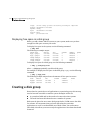
168 Creating and administering disk groups
Specifying a disk group to commands
Rules for determining the default disk group
It is recommended that you use the -g option to specify a disk group to VxVM
commands that accept this option. If you do not specify the disk group, VxVM
applies rules in the following order until it determines a disk group name:
■ Use the default disk group name that is specified by the environment
variable VXVM_DEFAULTDG. This variable can also be set to one of the
reserved system-wide disk group names: bootdg, defaultdg, or nodg. If
the variable is undefined, the following rule is applied.
■ Use the disk group that has been assigned to the system-wide default disk
group alias, defaultdg. See “Displaying and specifying the system-wide
default disk group” on page 168. If this alias is undefined, the following rule
is applied.
■ If the operation can be performed without requiring a disk group name (for
example, an edit operation on disk access records), do so.
If none of these rules succeeds, the requested operation fails.
Caution: In releases of VxVM prior to 4.0, a subset of commands attempted to
deduce the disk group by searching for the object name that was being operated
upon by a command. This functionality is no longer supported. Scripts that rely
on deducing the disk group from an object name may fail.
Displaying the system-wide boot disk group
To display the currently defined system-wide boot disk group, use the following
command:
# vxdg bootdg
See the vxdg(1M) manual page for more information.
Displaying and specifying the system-wide default disk group
To display the currently defined system-wide default disk group, use the
following command:
# vxdg defaultdg
If a default disk group has not been defined, nodg is displayed. Alternatively,
you can use the following command to display the default disk group:
# vxprint -Gng defaultdg 2>/dev/null
In this case, if there is no default disk group, nothing is displayed.
Use the following command to specify the name of the disk group that is aliased
by defaultdg:
# vxdctl defaultdg diskgroup


















